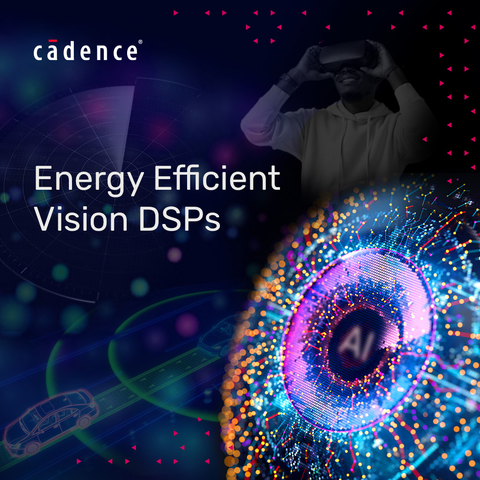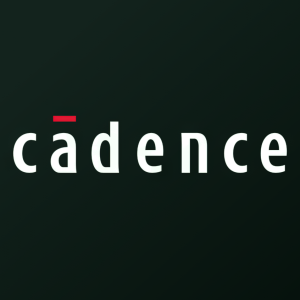Cadence Expands Tensilica Vision Family with Radar Accelerator and New DSPs Optimized for Automotive Applications
Highlights:
- Single DSPs for embedded vision, radar, lidar and AI processing boost performance while providing significant area, power and cost savings
- New radar accelerator provides a highly programmable hardware solution for offloading 4D imaging radar workloads, increasing performance
- Designed for sensor fusion processing in multi-sensor automotive, drone, robotics and autonomous vehicle system designs

Cadence expanded its Tensilica IP portfolio with two new Vision DSPs and a radar accelerator to address automotive sensor fusion applications. The new high-performance Cadence Tensilica Vision 331 DSP and Vision 341 DSP combine vision, radar, lidar and AI processing in a single DSP for multi-modal, sensor-based system designs, delivering the best energy efficiency in the smallest area. (Graphic: Business Wire)
“Automotive architectures continue to evolve with the current focus on software-defined vehicles and the growing prevalence of driver and occupancy monitoring systems,” said Raphaël Da Silva, Technology and Market Analyst at Yole Group. “With the automotive race towards eyes off, a mix of radars, cameras and Lidars are necessary to ensure optimal safety performance in all conditions. There are more than 40 sensors in a vehicle today, and that number will only continue to grow. Having these capabilities in a single, highly programmable DSP with a broad ecosystem is advantageous, particularly as imaging and 4D radar are expected to grow at a >
The new Vision 341 DSP and Vision 331 DSPs combine the proven Tensilica ConnX and Vision instruction-set architectures to offer SoC providers for automotive, drone, robotics and autonomous vehicle systems a highly programmable, single-DSP solution for image sensing, radar, lidar and AI workloads. Other features and benefits include:
- The 1024-bit Vision 341 DSP provides 2X multiply-accumulate (MAC) capability compared to the Vision 331 DSP while delivering the best performance and energy efficiency compared to GPUs or CPUs.
- For certain 4D imaging radar workloads, the 512-bit Vision 331 DSP offers up to 4X performance improvement over the Vision 230 DSP in radar boost mode, while the Vision 341 DSP offers up to 6X performance improvement compared to the Vision 230 DSP.
- When paired with the new DSPs for 4D imaging radar applications, the Vision 4DR accelerator offers 3X greater performance and up to 6X greater performance/area advantage compared to a Vision 341 DSP alone and 5X greater performance compared to a Vision 331 DSP alone.
- The new Vision DSPs deliver up to 2X computer vision performance improvements for computer vision filter and NMS algorithms, as well as AI improvements for quantization and depthwise separable convolution.
The Vision 341 and Vision 331 DSPs support the Tensilica Instruction Extension (TIE) language, allowing customers to customize the instruction set. The Cadence NeuroWeave™ Software Development Kit (SDK) provides neural network support for both DSPs. In addition, the Vision 341 and Vision 331 DSPs support more than 1700 OpenCV-based vision library functions, SLAM Library, Point Cloud Library (PCL), Radar library, Nature DSP library, OpenCL and the Halide compiler for computer vision, imaging, radar and lidar applications. Both cores are automotive ready with ASIL-B hardware random faults and ASIL-D systematic fault certification.
“With the growing prevalence of vision transformers, automotive SoC and systems companies need best-in-class performance for sensor fusion applications. Increasingly, they are seeking a highly flexible single-DSP solution for computer vision, radar and lidar with AI processing,” said David Glasco, VP of R&D for the Silicon Solutions Group at Cadence. “As the leading provider of vision and radar DSP IP, we’re extremely well positioned to capitalize on this growing need by offering our customers the best of both worlds in a single DSP with optional radar acceleration for emerging 4D radar applications.”
Customer Endorsements
“As a leading developer of SoCs for the ADAS market, Dreamchip sees growing use of 4D imaging radar in the near future. We continue to use Cadence Tensilica Vision DSPs in our SoCs and welcome the new DSPs that can accommodate cameras, radar and 4D radar acceleration while offering the highest performance in the smallest area.”
Jens Benndorf, Managing Director, CEO of Dreamchip
“SemiDrive continues to develop innovative SoCs for the infotainment market segments, and selecting an efficient processor and flexible DSP is crucial to our success. We continue to use Cadence Tensilica Vision DSPs in our products and welcome the new DSPs that can accommodate both cameras and radar. Additionally, Cadence’s extensive framework of software libraries and strong partner ecosystem enable rapid deployment for fast time to market.”
Eugene Wang, General Manager, Global Automotive Business at SemiDrive
Availability
Tensilica Vision DSPs support Cadence’s Intelligent System Design™ strategy, enabling SoC design excellence. The new Vision 331 DSP and Vision 341 DSP are available now, while the Vision 4DR accelerator will be in general availability in the second quarter of 2024. For more information on the Vision 331 DSP and Vision 341 DSP, please visit: https://www.cadence.com/go/vision-331-pr or https://www.cadence.com/go/vision-341-pr. More information on the Vision 4DR accelerator can be found at https://www.cadence.com/go/vision-4dr-accelerator-pr
About Cadence
Cadence is a pivotal leader in electronic design, building upon more than 30 years of computational software expertise. The company applies its underlying Intelligent System Design strategy to deliver software, hardware and IP that turn design concepts into reality. Cadence customers are the world’s most innovative companies, delivering extraordinary electronic products from chips to boards to systems for the most dynamic market applications, including consumer, hyperscale computing, 5G communications, automotive, mobile, aerospace, industrial and healthcare. For nine years in a row, Fortune magazine has named Cadence one of the 100 Best Companies to Work For. Learn more at cadence.com.
© 2024 Cadence Design Systems, Inc. All rights reserved worldwide. Cadence, the Cadence logo and the other Cadence marks found at www.cadence.com/go/trademarks are trademarks or registered trademarks of Cadence Design Systems, Inc. All other trademarks are the property of their respective owners.
Category: Featured
View source version on businesswire.com: https://www.businesswire.com/news/home/20240228430265/en/
Cadence Newsroom
408-944-7039
newsroom@cadence.com
Source: Cadence Design Systems, Inc.







